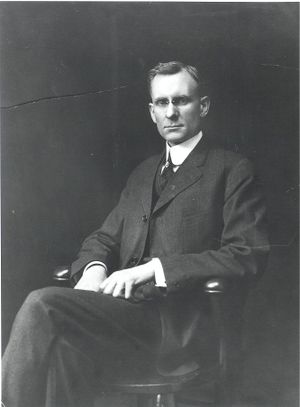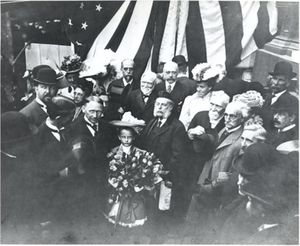Charles F. Scott
- Birthdate
- 1864/09/19
- Birthplace
- Athens, OH, USA
- Death date
- 1944/12/17
- Associated organizations
- Westinghouse Electric Corporation, Yale University
- Fields of study
- Power
- Awards
- AIEE Edison Medal
1902 -1903
Charles F. Scott, AIEE President, 1902 - 1903, created a new method for phase transformation called the “Scott Connection.” In 1911, Scott became an electrical engineering professor at Yale University, and he served as the head of the Electrical Engineering Program at the university.
Biography
Charles F. Scott was born in 1864 in Athens, OH, where his father was a member of the faculty at Ohio University. Scott spent two years as an undergraduate at Ohio University before transferring to Ohio State University, from which he graduated in 1885. He then did graduate work in mathematics and physics at The Johns Hopkins University before joining the engineering staff of the Westinghouse Electric and Manufacturing Company in Pittsburgh, PA, in 1888. One of his first assignments was to assist the legendary inventor Nikola Tesla in developmental work on the alternating-current induction motor.
Power Transmission Efforts
Scott also participated in the design of a pioneering alternating-current power installation near Telluride, CO, which began operation in 1891. This project was designed to transmit power from a hydroelectric plant to a mining facility more than two miles away. Scott and his colleagues, including R. D. Mershon, used the Telluride transmission line for field experiments on losses due to corona discharge at high voltage. In a technical paper based on these investigations, Scott wrote that "the wires began to give a hissing or crackling sound and in the dark began to appear luminous at a little below 20 000 volts. As the voltage was increased the sound became more and more intense, the wires vibrated and became more and more luminous until at the higher voltages they were surrounded by a coating of blue light many times the diameter of the wire." He concluded that 40000 or 50000 volts would be the highest transmission-line voltage that could be used without excessive losses unless the corona problem could be overcome. Scott's analysis stimulated H. J. Ryan of Cornell University to carry out further research in the early twentieth century, which showed how to minimize corona losses by increasing the diameter and spacing of transmission-line conductors. This in turn enabled the use of much transmission voltages than Scott had recommended.
Scott reported on his new method of phase transformation, which became known as the "Scott connection," in a paper presented at a meeting of the National Electric Light Association in March 1894. He stated that "in considering the marked advantages of the two-phase system for distribution and of the three-phase system for transmission, it occurred to me that a combination of the two systems might secure the advantages of both, and I have worked out a simple and effective method of accomplishing this result."
His technique utilized two transformers connected so that two-phase power applied to the primary windings transformed to three-phase power from the secondary windings. Among the first applications of the Scott connection was the conversion of the output of two-phase generators at a large hydroelectric plant at Niagara Falls, NY to three-phase power feeding a transmission line to Buffalo, NY, in 1896.
Service
Rapid growth in the membership of the AIEE during the 1890s and the changing environment of engineering practice produced stresses that Scott addressed during his 1902 to 1903 tenure as AIEE president. He used statistical data that reflected changing patterns of employment and education to justify institutional innovations, including student branches and technical committees. He wrote to immediate past president C. P. Steinmetz that technical committees would encourage continued growth of the AIEE by helping members to keep in "touch with the latest engineering practice in new lines." Scott advocated engineering unity and called for greater cooperation among the various engineering societies. To facilitate interaction and cooperation, he proposed a single location as a home for American engineering societies and managed to persuade the philanthropist Andrew Carnegie to donate funds needed to construct a 13-story engineering societies building in New York City.
In 1911, Scott resigned from Westinghouse to become a professor and head of the Electrical Engineering Program of the Sheffield Scientific School at Yale University. During World War I, he and some Yale colleagues engaged in research related to antisubmarine warfare. He founded the AIEE Connecticut Section in April 1921 and served as its first Chairman. In 1929, Scott received the prestigious Edison Medal of the AIEE as recognition of his early contributions to the field of polyphase power transmission. The same year, he was elected an honorary member of the AIEE. He retired from Yale in 1933 and died in 1944 at age 80.
Photographs
Further Reading





